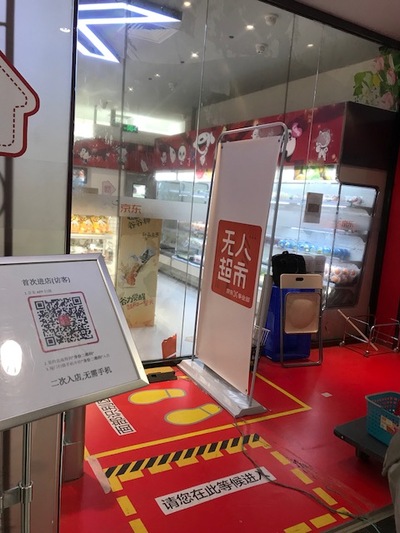- In shops and office buildings across China, digital payments and facial recognition applications suffuse everyday life.
- During corporate meetings, discussions of artificial intelligence (AI) surfaced in unexpected places, including regional state-owned banks and household appliance makers. I believe this phenomenon, at least partly, reflects Beijing’s decision to make AI development a national strategic priority.
- A more worrying technology trend is that several online ecosystems – ranging from food delivery to mobile payments to ride-sharing – have become consolidated by the same three Internet giants. In the long term, I believe that Chinese consumers will bear the cost of market concentration in the form of anti-competitive practices.
During a recent trip to China, I observed how much facial recognition and digital payments suffused everyday life. A receptionist took my photo as I registered for a meeting with a state-owned enterprise (SOE). Moments later, I unlocked access to the building’s elevators by staring into a screen. On the streets, cash use has declined rapidly with the growing prominence of mobile payment applications WeChat Pay and Alipay, leaving little room for credit cards. As a foreigner without the capability to open a WeChat wallet, finding restaurants and shops (outside of Starbucks) that would accept my Visa was a constant struggle.
During corporate meetings, discussions returned repeatedly to technology investments, even in unlikely places. Seemingly every state-owned bank I met with was actively investing in their mobile apps, as well as artificial intelligence (AI) software for branch automation. I was initially skeptical of the sector embracing financial technologies (or “fintech”). After all, the list of regulatory mandates facing the banking sector’s bread and butter operations is already arduous. For example, Chinese banks need to reduce real estate-related lending, cut their exposure to lucrative wealth management products (WMPs), and promote credit access to economically challenged rural populations – all while navigating a backdrop of top-down de-leveraging. Furthermore, to align with Communist Party principles, banks are expected to support China’s Belt & Road initiative by facilitating large-scale infrastructure investments in unfamiliar countries such as Laos and Nigeria. Where can the Chinese banks find the time to invest in internet finance?
The answer seems to be that banks cannot afford to not develop with the fintech industry. They are faced with the threat of ceding even more market share to cash-rich and relatively unregulated “pure fintech” companies. China’s social media giants have already used big data to automate “instant loans,” which are available to consumers and small businesses at the tap of a mobile app and are clearly the preferred channel for day-to-day transactions. One bank I met with unequivocally considered fintech to be its top threat and was fighting back. This corporate had recently dedicated 1% of profits to fintech research and development (R&D) investment and was prepared to increase this to 1% of revenue. Early results of this bank’s investment efforts included a robo-advisor for consumers investing as little as 20,000 renminbi (roughly equivalent to 3,000 U.S. dollars). The meeting ended on a hopeful note, with the manager remarking that his bank, as well as other SOE banks, were awakened to the fintech threat just as regulators were reconsidering their light-touch regulatory stance toward pure-fintech players.
Another corporate that had redefined itself through technology was a leading manufacturer of refrigerators and washing machines. Through a do-it-yourself website, customers can customize and purchase household appliances online, which are then quickly delivered through a tightly controlled distribution system. Like other major Chinese appliance manufacturers, this company has been consistently investing 3% to 5% of its sales back into R&D. The company’s smart appliances include washing machines that automatically scan clothing labels to set the correct wash settings, and refrigerators that use AI to reduce food spoilage. The company’s entrepreneurial chairman oversaw the company’s slow rise from a failing refrigerator factory 30 years ago to a company preparing for global “platform dominance” via software standards alliances and a stream of overseas acquisitions.
While I was convinced of these companies’ technology prowess, I also noticed a more troubling trend of rapid consolidation. In Hong Kong, my taxis had as many as five cell phones affixed to their dashboards in order to receive passenger alerts through multiple apps. In contrast, in China, there was a single online platform that managed all taxis and ride shares. Since Didi Chuxing (“Didi”) bought out Uber’s local operation in 2016, mainland Chinese passengers have been frustrated by fare hikes and abrupt ride cancelations. Before achieving its monopoly status, Didi had received financial backing from three leading Chinese internet companies – Baidu, Alibaba, and Tencent (the “BATs”). This pattern of BAT-determined dominance played out similarly in the bike-sharing and food delivery arenas. In each instance, a vibrant collection of start-ups had quickly collapsed into one or two winners, reflecting the financial dominance of their parent companies. One Beijing local who had tried a brief stint in medical technology noted bluntly that start-ups needed backing from at least one of the BAT companies “just to survive.”
In past decades, Chinese technology evolved creatively and relatively independently of its Western counterparts to suit the needs of the local market, as evidenced by clusters of brightly colored shared bikes, and the billions of virtual red envelopes exchanged over the Lunar New Year. Entrepreneurs, like the chairman of the appliance maker, innovated their way to the top of fragmented playing fields, leaving consumers better off as they did so. With technological innovation increasingly concentrated in a few of China’s largest companies, I sincerely hope that the newest generation of Chinese founders will find similar opportunities.
Stephanie GanBeijing






- The views and information discussed in this commentary are as of the date of publication, are subject to change, and may not reflect Seafarer’s current views. The views expressed represent an assessment of market conditions at a specific point in time, are opinions only and should not be relied upon as investment advice regarding a particular investment or markets in general. Such information does not constitute a recommendation to buy or sell specific securities or investment vehicles. It should not be assumed that any investment will be profitable or will equal the performance of the portfolios or any securities or any sectors mentioned herein. The subject matter contained herein has been derived from several sources believed to be reliable and accurate at the time of compilation. Seafarer does not accept any liability for losses either direct or consequential caused by the use of this information.
- As of March 31, 2018 the Seafarer Funds had no economic interest in the entities referenced in this commentary.
![[Chrome]](/_layout/images/ua/chrome.png)
![[Firefox]](/_layout/images/ua/firefox.png)
![[Opera]](/_layout/images/ua/opera.png)
![[Microsoft Edge]](/_layout/images/ua/edge.png)